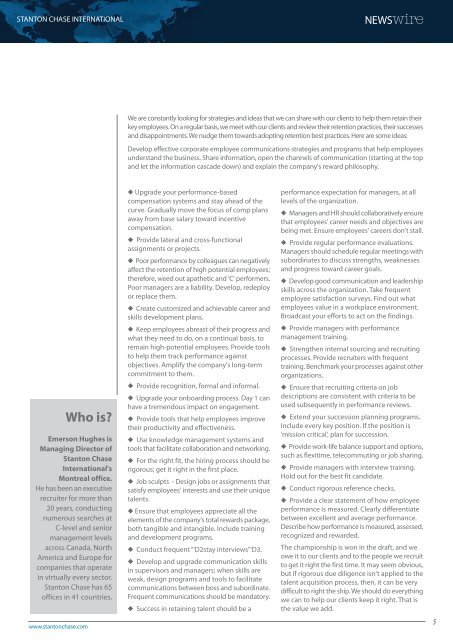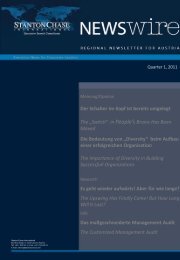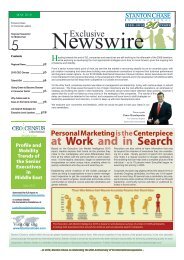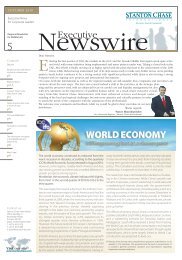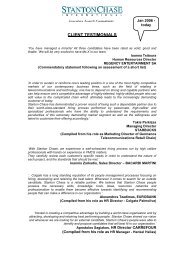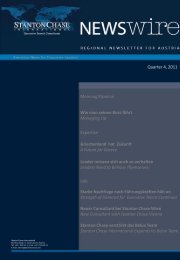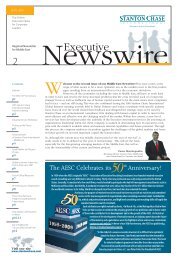Management Audit with Stanton Chase's Executive Assess ...
Management Audit with Stanton Chase's Executive Assess ...
Management Audit with Stanton Chase's Executive Assess ...
You also want an ePaper? Increase the reach of your titles
YUMPU automatically turns print PDFs into web optimized ePapers that Google loves.
STANTON CHASE INTERNATIONAL<br />
Who is?<br />
Emerson Hughes is<br />
Managing Director of<br />
<strong>Stanton</strong> Chase<br />
International's<br />
Montreal office.<br />
He has been an executive<br />
recruiter for more than<br />
20 years, conducting<br />
numerous searches at<br />
C-level and senior<br />
management levels<br />
across Canada, North<br />
America and Europe for<br />
companies that operate<br />
in virtually every sector.<br />
<strong>Stanton</strong> Chase has 65<br />
offices in 41 countries.<br />
www.stantonchase.com<br />
We are constantly looking for strategies and ideas that we can share <strong>with</strong> our clients to help them retain their<br />
key employees. On a regular basis, we meet <strong>with</strong> our clients and review their retention practices, their successes<br />
and disappointments. We nudge them towards adopting retention best practices. Here are some ideas:<br />
Develop effective corporate employee communications strategies and programs that help employees<br />
understand the business. Share information, open the channels of communication (starting at the top<br />
and let the information cascade down) and explain the company's reward philosophy.<br />
◆ Upgrade your performance-based<br />
compensation systems and stay ahead of the<br />
curve. Gradually move the focus of comp plans<br />
away from base salary toward incentive<br />
compensation.<br />
◆ Provide lateral and cross-functional<br />
assignments or projects.<br />
◆ Poor performance by colleagues can negatively<br />
affect the retention of high potential employees;<br />
therefore, weed out apathetic and 'C' performers.<br />
Poor managers are a liability. Develop, redeploy<br />
or replace them.<br />
◆ Create customized and achievable career and<br />
skills development plans.<br />
◆ Keep employees abreast of their progress and<br />
what they need to do, on a continual basis, to<br />
remain high-potential employees. Provide tools<br />
to help them track performance against<br />
objectives. Amplify the company's long-term<br />
commitment to them.<br />
◆ Provide recognition, formal and informal.<br />
◆ Upgrade your onboarding process. Day 1 can<br />
have a tremendous impact on engagement.<br />
◆ Provide tools that help employees improve<br />
their productivity and effectiveness.<br />
◆ Use knowledge management systems and<br />
tools that facilitate collaboration and networking.<br />
◆ For the right fit, the hiring process should be<br />
rigorous; get it right in the first place.<br />
◆ Job sculpts - Design jobs or assignments that<br />
satisfy employees' interests and use their unique<br />
talents.<br />
◆ Ensure that employees appreciate all the<br />
elements of the company's total rewards package,<br />
both tangible and intangible. Include training<br />
and development programs.<br />
◆ Conduct frequent “'D2stay interviews”'D3.<br />
◆ Develop and upgrade communication skills<br />
in supervisors and managers; when skills are<br />
weak, design programs and tools to facilitate<br />
communications between boss and subordinate.<br />
Frequent communications should be mandatory.<br />
◆ Success in retaining talent should be a<br />
performance expectation for managers, at all<br />
levels of the organization.<br />
◆ Managers and HR should collaboratively ensure<br />
that employees' career needs and objectives are<br />
being met. Ensure employees' careers don't stall.<br />
◆ Provide regular performance evaluations.<br />
Managers should schedule regular meetings <strong>with</strong><br />
subordinates to discuss strengths, weaknesses<br />
and progress toward career goals.<br />
◆ Develop good communication and leadership<br />
skills across the organization. Take frequent<br />
employee satisfaction surveys. Find out what<br />
employees value in a workplace environment.<br />
Broadcast your efforts to act on the findings.<br />
◆ Provide managers <strong>with</strong> performance<br />
management training.<br />
◆ Strengthen internal sourcing and recruiting<br />
processes. Provide recruiters <strong>with</strong> frequent<br />
training. Benchmark your processes against other<br />
organizations.<br />
◆ Ensure that recruiting criteria on job<br />
descriptions are consistent <strong>with</strong> criteria to be<br />
used subsequently in performance reviews.<br />
◆ Extend your succession planning programs.<br />
Include every key position. If the position is<br />
'mission critical', plan for succession.<br />
◆ Provide work-life balance support and options,<br />
such as flexitime, telecommuting or job sharing.<br />
◆ Provide managers <strong>with</strong> interview training.<br />
Hold out for the best fit candidate.<br />
◆ Conduct rigorous reference checks.<br />
◆ Provide a clear statement of how employee<br />
performance is measured. Clearly differentiate<br />
between excellent and average performance.<br />
Describe how performance is measured, assessed,<br />
recognized and rewarded.<br />
The championship is won in the draft, and we<br />
owe it to our clients and to the people we recruit<br />
to get it right the first time. It may seem obvious,<br />
but if rigorous due diligence isn't applied to the<br />
talent acquisition process, then, it can be very<br />
difficult to right the ship. We should do everything<br />
we can to help our clients keep it right. That is<br />
the value we add.<br />
5


